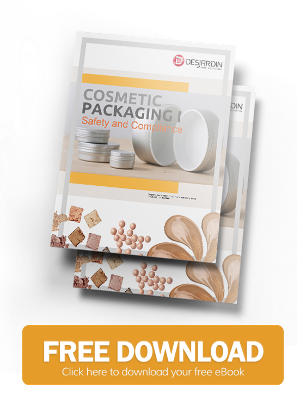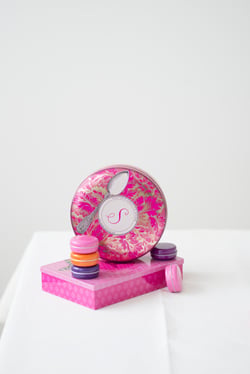The beauty industry relies on attractive cosmetic containers as part of its marketing, but it must also pay attention to labelling to meet federal regulations. These regulations, however, are not very comprehensive compared with other common retail commodities. The key is to be straightforward with consumers, which helps build loyalty as well. Here are points that cosmetic vendors should keep in mind when designing labels.
General Label Guidelines
- colorful appearance
- easy to read with crisp appearance
- effective print
- multiple languages (depending on where it is sold)
- accurate information (brand name, description and quantity of contents)
Economics of Print or Stick Labelling
 Whether labels are printed directly on the container or on adhesives that are applied in an extra step, the economics depend on the number of colors, amount of volume and the overall process. A black on white label, for example, will always cost less than a 4-color label. The CMYK (cyan, magenta, yellow and key aka black) color model is standard across various forms of printing. An alternative is the RGB (red, green, blue) model, while there are other color models as well, depending on the printing process.
Whether labels are printed directly on the container or on adhesives that are applied in an extra step, the economics depend on the number of colors, amount of volume and the overall process. A black on white label, for example, will always cost less than a 4-color label. The CMYK (cyan, magenta, yellow and key aka black) color model is standard across various forms of printing. An alternative is the RGB (red, green, blue) model, while there are other color models as well, depending on the printing process.
The majority of tin cans on the market have labels made of paper or plastic that are glued to the can being printed. This method is cheaper and more practical than printing directly on a container. Labels can be mass produced and then attached to containers. Printing on paper with a laser printer has quality drawbacks, since the ink can cause bleeding, smudging and smearing, due to the high printing temperature.
Printing on a clear film is required when using a laser printer, as laminates and labor factor into the cost. An alternative is use of a thermal printer, which is more cost effective for low volume printing. Thermal printers operate at lower temperatures, making them more resistant to smudging and scratching. They also don't require over laminating. For these reasons, thermal printers are more favored for printing bar codes. Another advantage to thermal printing is that they are more reliable for high volume printing and are less likely to generate waste.
Federal Regulations Compliance
 As defined by the FD&C Act, "label" means "written, printed or graphic matter affixed to any consumer commodity or affixed to or appearing upon a package."
As defined by the FD&C Act, "label" means "written, printed or graphic matter affixed to any consumer commodity or affixed to or appearing upon a package."
The Fair Packaging and Labelling Act took effect in 1966, mandating specific requirements for cosmetic containers. First, the label must display the usual name of the brand, which should not be confused with any other product on the market. The label must also list the address of the manufacturer, packer or distributor. Finally, the net quantity of the the contents within the container must be listed. The measurement unit of this quantity varies, depending on what's appropriate. It may be measured in weight, area, number of units or volume.
The FDA requires that ingredients of cosmetic products must be listed on the label, although the main concern for manufacturers is whether or not the product contains colorants. Ingredients should be listed on the primary container or secondary package, if the product contains at least two ingredients. Raw materials need not be listed.
Honest Labelling
Labels must avoid any type of misleading information, as per Chapter 39 of the Fair Packaging and Labelling Program. The cosmetic industry must also comply with the requirements of the Federal Food, Drug and Cosmetic Act, as well as the FDA. If a federal agency is alerted that the labelling contains false or deceptive information, the vendor can suffer penalties for "misbranding."
Another key point that for cosmetic containers is that the intended use must be clear explained on the label. The risks of misuse must also be specific with instructions what to do as a solution.
Conclusion
Cosmetic containers must contain labels that allow the consumer to know what they are buying. The labels must comply with FDA and other government regulations and should conform with ISO guidelines. While the cosmetic industry is not closely regulated by federal authorities, it's still important to be in complete compliance with all regulations to avoid fines and recalls. Labels must also be legible and attractive for marketing purposes.
Disclaimer:
The postings in this blog section do not necessarily represent Desjardin's positions, strategies or opinions.
References and Further Reading
- More posts on Cosmetic Packaging, by Alex Cosper and Dawn M. Turner
- Is It a Cosmetic, a Drug, or Both? (2016), by the U.S. Food and Drug Administration
- Regulation (EC) No ´1223/2009 on Cosmetic Products (2009), The European Parliament the the European Council
- ISO 22715:2006: Cosmetics -- Packaging and labelling (2006), International Organization for Standardization
- 4 Tips for Researching and Finding Wholesale Suppliers (2012), US Small Business Association
- 13 Tips for Negotiating with Suppliers (2012), Inc
- Supplier Selection (2009), Damian Bell
Photo: "Cosmetics", Courtesy of Practical Cures, Flickr, (CC BY 2.0)







